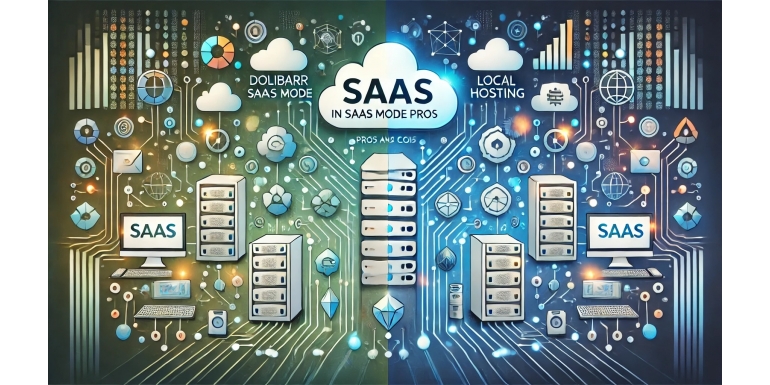
The Dolibarr ERP and CRM is an open-source solution that enables businesses to efficiently manage their operations, including invoicing, accounting, stock management, human resources, and customer tracking. However, when installing Dolibarr, businesses have two main options: local hosting (On-Premise) or SaaS (Software as a Service).
Which option is best for your business? Should you opt for an in-house server, which offers total control, or cloud hosting, which simplifies management and reduces initial costs? This in-depth article explores the advantages and disadvantages of both hosting options to help you make the best choice.
1️⃣ Understanding the Two Dolibarr Hosting Options
Before comparing the advantages and disadvantages of each option, it’s essential to understand their fundamental differences.
✅ Dolibarr in SaaS Mode (Cloud - External Hosting)
The SaaS (Software as a Service) model means that Dolibarr is hosted on a remote server and accessed via a web browser. Users subscribe to a plan and use Dolibarr without managing the technical infrastructure.
✔ The provider or a third-party host manages hosting, maintenance, and updates.
✔ No installation required on the company’s servers.
✔ Accessible from anywhere with an internet connection.
✅ Dolibarr in Local Hosting (On-Premise - Private Server)
The On-Premise hosting model means that Dolibarr is installed on a private server owned by the company or hosted in a private data center.
✔ The company has full control over the ERP and data storage.
✔ Data remains in-house, which can be crucial for security reasons.
✔ Greater customization options for the server and software features.
1️⃣ Dolibarr in SaaS Mode: Advantages and Disadvantages
✅ Advantages of SaaS Mode
1️⃣ Easy Deployment and Usage
✔ No need for advanced IT infrastructure.
✔ Installation, configuration, and updates are automated.
✔ Ideal for SMEs and startups without an in-house IT team.
2️⃣ Accessibility and Mobility
✔ Accessible from any device with an internet connection.
✔ Perfect for remote work and teams on the go.
✔ Multi-user functionality without complex network setup.
3️⃣ Maintenance and Support Included
✔ SaaS hosting includes security management, backups, and updates.
✔ Technical support is available in case of issues.
4️⃣ Scalability and Flexibility
✔ Ability to upgrade plans as the business grows.
✔ Easily add users and features as needed.
❌ Disadvantages of SaaS Mode
1️⃣ Internet Dependency
❌ Dolibarr SaaS requires an internet connection to function.
❌ Slow or unstable internet can affect work efficiency.
2️⃣ Less Control Over Data
❌ Data is stored on an external server, raising privacy concerns.
❌ Dependency on the provider (if the service is discontinued, migration can be complex).
3️⃣ Higher Long-Term Costs
❌ A monthly subscription can become expensive over time.
❌ Additional costs may apply for premium features or extensions.
1️⃣ Dolibarr in Local Hosting: Advantages and Disadvantages
✅ Advantages of Local Hosting
1️⃣ Full Control Over Infrastructure and Data
✔ The company owns and manages its entire server and databases.
✔ Ideal for companies handling sensitive data (banks, healthcare, industrial sectors, etc.).
2️⃣ Better Security and Compliance
✔ Allows businesses to meet strict data privacy regulations (GDPR, ISO 27001, etc.).
✔ Less risk of data breaches, as no third party has access to the information.
3️⃣ Advanced Customization
✔ Possibility to install custom modules and modify the source code.
✔ Direct database access for advanced integrations with other software.
4️⃣ Lower Long-Term Costs
✔ No recurring monthly fees, unlike the SaaS model.
✔ Ideal for large enterprises looking to maximize their infrastructure investment.
❌ Disadvantages of Local Hosting
1️⃣ Higher Initial Investment
❌ Requires purchasing servers, infrastructure, and licenses.
❌ Needs an IT team for installation and server management.
2️⃣ Maintenance and Updates Must Be Managed Internally
❌ Responsible for backups, updates, and security patches.
❌ Risk of hardware obsolescence, requiring periodic upgrades.
3️⃣ Limited Accessibility
❌ Less suitable for remote work and mobile teams.
❌ Requires VPN or remote access setup for off-site users.
1️⃣ Detailed Comparison: Dolibarr SaaS vs. Local Hosting
| Criteria | Dolibarr in SaaS Mode | Dolibarr in Local Hosting |
|---|---|---|
| Initial Cost | Low (monthly subscription) | High (hardware and setup costs) |
| Long-Term Cost | Higher (ongoing subscription) | Cost-effective over time |
| Implementation | Quick and easy | Complex installation required |
| Maintenance | Managed by the provider | Managed in-house |
| Security | Depends on cloud provider | Full control over data |
| Accessibility | Accessible from anywhere | Limited without VPN |
| Customization | Limited to provider options | Full customization possible |
1️⃣ Which Solution Is Right for Your Business?
✔ Choose Dolibarr SaaS if…
- You are a startup or SME with limited technical resources.
- You want to avoid infrastructure and maintenance hassles.
- Your team works remotely or frequently travels.
✔ Choose Dolibarr in Local Hosting if…
- You require strict security and absolute data privacy.
- You want to fully customize Dolibarr with specific modules.
- Your company can manage an IT infrastructure or already has a dedicated server.
???? Conclusion: Dolibarr, a Flexible ERP for All Needs
⭐ Whether you choose Dolibarr in SaaS mode or local hosting, the key is selecting the option that aligns with your security, flexibility, and budget requirements.
✅ If you prioritize simplicity and accessibility, SaaS is ideal. If you want total control and enhanced security, local hosting is the best choice.
???? Which solution do you currently use for your business? Share your experience in the comments!
